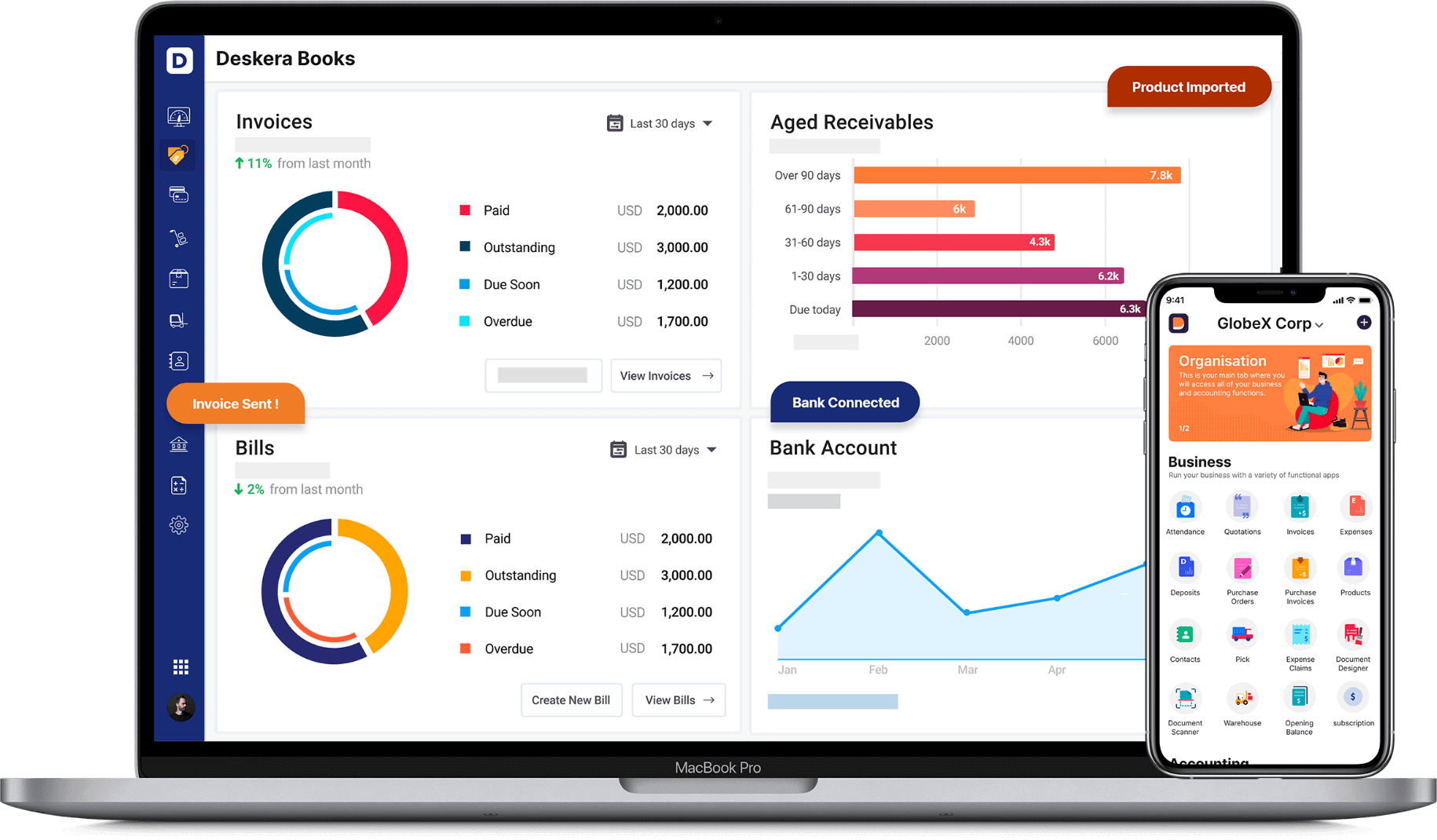As a businessman, you have to analyze the stature and health of your business and generate financial statements. To bolster that, you have to take recourse to financial accounting.
Accounting makes you record, classify and summarize all transactions of economic relevance to the business. Financial accounting is different from other types of accounting.
In its methodology, you have a method for documenting, summarizing, and reporting. These relate to all transactions which happen within the business operations in a particular period. It involves the preparations of accounts, including an income statement and a cash flow statement within it. These are the two most important items within financial accounting.
Financial Accounting's main topics revolve around the core accounting equation:
Assets = Liability + Owners' Equity
The trial balance, usually prepared using the double-entry accounting system, forms the basis for preparing the financial statements. All the figures in the trial balance are rearranged to prepare a profit & loss statement and balance sheet. Accounting standards determine the format for these accounts (SSAP, FRS, IFRS).
Financial statements display the income and expenditure for the company and a summary of the assets, liabilities, and shareholders' or owners' equity of the company on the date to which the accounts were prepared.
There are various types of statements too that financial accounts produce, together with different principles it follows while you generate the statements mentioned above.
So, financial accounting reports are vital in understanding and recognizing the goals set by the company for the future as well as those from the past which have been achieved. They determine for you how your company will operate, the number of staff you can employ, you should employ, as well as that of additional resources you can potentially allocate to other departments of your company.
In India, most companies have to report all transactions during the fiscal year, i.e., 1st April to 31st March. This form of accounting reflects accounting on "accrual basis”. The other form used is the one on a “cash basis.” Therefore, almost every small/medium/large business, NGO, company, organization, club, etc., needs financial accounting and indeed uses them.
This type of accounting generates several different types of statements, and these are usually shared with stakeholders.
Financial Accounting Statement
The following are the terms used within financial accounting statement:
Income Statement
This is the kind that works out your net income. It does so by taking away your revenue from your expenses. Revenue is again added once you sell a product. Or your customer confirms completion of any service.
Balance Sheet
This is crafted at the end of any period you might have to monitor for financial activity, usually every quarter or fiscal year. Some companies also do it for a calendar year, depending on the requirements of their stakeholders. The balance sheet decides what the values are of the assets you have. This is derived by adding the liabilities and the equity stakeholders possess.
Retained Earnings Statement
This has to do with the dividends the company pays to shareholders and earnings you kept aside to plow back later into your business.
Cash flow Statement
This is the total capital and delineates how much fund is coming into and out of your business. It takes into account factors like operational costs as well as financial and investment costs.
Accounting and Financial Accounting: What is the Difference?
Although on the face of it, much of accounting seems just the same, to do with debit and credit, in reality, it can be significantly different. Financial accounting is different as it deals only with generating statements conforming to Generally Accepted Accounting Principles (GAAP). However, accounting deals with various aspects of your company’s finances and transactions. These may include payroll, inventory, debt, and revenue, among other things.
Financial Accounting – The Two Methods
In principle, there are two ways you and your company can record all transactions. A company can use either of them, use both, or a mix of both as it suits the business.
Cash Accounting
As the term suggests, cash accounting records cash transactions by your employees in the company. These include but are not limited to travel expenses by an employee on a business trip, meals, staying, and other incidental expenses. Once they spend the money, they keep the receipt and come and deposit all their expenses to their supervisor. The employee logs them in the system once they are approved. These transactions don’t usually show up in financial statements but are often kept to prove that they happened.
Accrual Accounting
Here, the accountant records every data from all transactions. This is cash accounting with many layers added to it – incorporating debit, credit, and all other forms of payment when employees, including cash transactions, made transactions. These also bring accounts payable and receivable within its ambit, representing capital for which you are in debt to a customer/vendor, or it’s the other way round. This gives an obvious idea of your company’s cashflow status, helping you understand and determine your current assets and liabilities.
The Basic Principles of Financial Accounting
This system follows some basic guidelines for generating statements for stakeholders. As mentioned earlier – these are called Generally Accepted Accounting Principles (GAAP). These guidelines are the cornerstones of financial accounting. All auditors and bookkeepers have to comprehend the detailed rules issued by the Financial Accounting Standards Board, and they have to abide by the industry- standard or best practices.
Let’s talk more about the main accounting principles you need to keep in mind.
Economic entity assumption
This is the principle of making sure you separate your business transactions from those you have made which are not relevant to the business – things you bought outside the company. Here, your business and you are two separate entities.
Cost principle
This wants you to document every continuous and complex financial activity over a predetermined period. This needs to be presented right at the top of every financial statement produced for ease of understanding. Thus presented, it gives stakeholders a complete understanding of the amount of capital spent over the period indicated. It helps understand the cash flow of your business and is based on the numbers you present to stakeholders.
Full-disclosure principle
It is expected that lenders and investors are acquainted with each critical financial information, and they can see them clearly in the financial statement. The financial statements adhering to this principle have a footnote to inform stakeholders about information around financial transactions made.
Matching principle
You have to use accrual accounting and not cash accounting when recording transactions. When adhering to this principle, it is also a necessity that you must align your company’s expenses with revenue earned. For example, if you had to pay commissions from purchases during a specific quarter, it should be reported when the customer purchased it. Wage costs in this principle should also be reported during the week an employee worked, which might be different from their pay period.
Going concern principle
This takes it for granted that you will fulfill all your financial obligations when you liquidate shortly. Your intention to liquidate must be very clearly marked in every financial statement you send out. You could defer prepaid expenses and show them in future accounting statements if there is a liquidation.
Revenue recognition principle
A company accrues revenue after making a sale or providing a service to customers. While a company can earn, say, Rs 10,000, they might only receive Rs 1,000 in cash. A cash receipt confirms payment and proof of cash coming into a company.
Conservatism
This gives you an excellent opportunity to showcase potential/future losses without having to show potential/future gains. This is a good way to record the financial activity and potential dangers in detail, and they could appear in future financial statements.
Materiality
For a cash amount that is not relevant, some accounting principles can be violated in the interest of ease of business. This is a logical step ahead when the situation so demands. For instance, it is OK to charge an expense over three years despite paying it immediately. This, while a violation of the material principle, i.e., not getting charged within the time it is bought, can be regularized by a footnote in the financial statement, mentioning the cost of allocation over a differing period.
Three essential tips for recording financial transactions
Simply put, you need to keep in mind three tips for success in recording financial transactions:
Know the two different types of accounting very well
While one form of accounting, say, accrual accounting, might be good to track financial outcomes of your business and the temptation would be to go ahead with that, it’s always a good idea to know the basic tenets of cash accounting and recognize that it is a part of it. It also comes in handy while tracking digital transactions.
It is always good to hire a good accountant or bookkeeper, but you need to document every financial record.
Know which statements you should use
The type of business you have should determine the financial statements to use. For example, if your company has other investors, it is generally a good idea to use all of them, as this adds to the transparency of your financial information and adds credibility. In business, transparency adds credibility, which almost always leads to investors trusting you in your efforts to keep your company healthy and adding potential investors.
Application of accounting principles
It is vital to adhere to accounting principles all the time. This keeps you responsible and your financial records straight and honest, helping you properly register your quarterly and annual costs.
Whichever way you look at it, accounting is the process of identifying, recording, classifying, measuring, verifying, and communicating financial information. In the end, it reveals profit and loss and the business's equity.
How can Deskera Help You?
Deskera Books can help you automate and mitigate your business risks. Creating invoices becomes easier with Deskera, which automates a lot of other procedures, reducing your team's administrative workload.
Sign up now to avail more advantages from Deskera.

Learn about the exceptional and all-in-one software here:
Key Takeaways
- Financial accounting mainly focuses on the core accounting equation: Assets = Liability + Owners' Equity
- There are a few kinds of Financial Accounting statements - Income Statements, Balance Sheets, Retained earnings statements, and cash flow statements
- The basic principles of Financial Accounting are Economic Entity Assumption, Cost Principle, Full Disclosure Principle, Matching Principle, Going Concern Principle, Revenue Recognition Principle, Conservatism and Materiality
- Three tips for recording financial transactions: know the two different types of accounting very well, know which statement you should use, and the application of accounting principles
Related Articles












